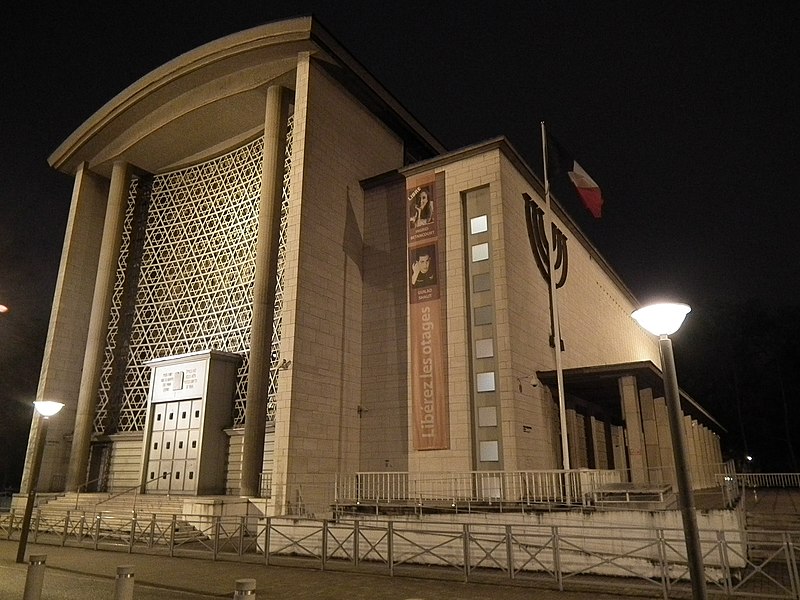
The Quai Kléber Synagogue was built from 1895–98 in the Neustadt district of Strasbourg, France (then part of the German Empire), in an impressive Romanesque Revival style designed by architect Ludwig Levy. It was inspired by similar imposing buildings in the Rhine region, esp. the cathedrals of Mainz, Worms, and Speyer.
In German, the shul was known as Synagoge am Kleberstaden and Neue Synagoge. Though Strasbourg was part of Germany till 1918, most of its Jewish community was French. Alsace–Lorraine has a long, complicated history owing to its position at the German–French border.

The city’s first shul was built at 14 Rue Sainte-Hélène in 1834, on the site of the Order of Friars Minor Capuchin’s former convent, but the big increase in Jewish population during the second half of the 19th century called for a much larger building. Plans to build a new shul started in 1889.

Interior of the original shul
The construction cost about 750,000–800,000 marks ($7,054,065.57–$7,524,336.79 in 2024). Structural work wrapped up in November 1897, followed by work on interior design. It was consecrated and opened to the public on 8 September 1898, with 1,639 seats (825 in the men’s section, 654 in the ladies’ gallery, 100 in the oratory, 40 for choristers around the Ark).
Like the original shul, the new one too had an organ, made by Walcker Orgelbau. In 1925, it had to be replaced once more, since it was falling apart. The third organ, made by Edmond-Alexandre Roethinger, had 62 stops, three keyboards with 56 keys each, and a pedal board with 32 steps.
To mark the inauguration of the third organ, there was a concert on 25 August 1925, featuring Émile Rupp (the shul’s organist since 1914) and other musicians from Paris and Strasbourg. It was Monsieur Rupp who suggested the second organ needed replacing in 1923.

The façade was built of pink and grey Vosges sandstone from Phalsbourg quarries. The stained-glass windows (including rose windows) were created by architect and glass painter Alexander Linnemann.

Disaster struck when the Nazis invaded and occupied Alsace in 1940. The shul was looted, and a fire was lit on 12 September. It was entirely burnt to the ground on the night of 30 September–1 October, and the ruins were dynamited in October 1941.
Typically, the Nazis blamed the Jewish community for their own evil acts, despite the fact that they’d already evacuated or been kicked out of the city in September 1939. Since they weren’t allowed to return to Strasbourg, the looted items in the surrounding buildings were auctioned off or stolen.
Nothing of the last organ is known to exist, but parts of the 1914 organ were put into the organ of Mauritius Church in 1942.

Survivors who returned to Strasbourg after the war met at Palais des Fêtes on Rue Sellénick, a performance hall which had been used as Gestapo HQ and had since been converted into an ORT school. ORT (Organisation for Rehabilitation through Training) is a worldwide Jewish educational network founded in 1880 in St. Petersburg.
From 1948–58, they set up shop in a temporary shul at a former arsenal on Place Broglie (now a military chaplaincy’s chapel). A new shul was constructed on land in Contades Park, exchanged for land along Quai Kléber in 1952.
The Great Synagogue of Peace was consecrated on 23 May 1958, with 1,658 seats.

Synagogue de la Paix, Copyright Alkhimov Maxim, Creative Commons Attribution 3.0 Unported

Copyright Claude TRUONG-NGOC (Ctruongngoc), Wikimedia Commons – cc-by-sa-4.0
In the spring of 2013, a stone handwashing basin from the Quai Kléber Synagogue was discovered in a Strasbourg garden, where it had been for decades. It was given to the Jewish community, who placed it in the Cronenbourg cemetery.
The remains of a stone lion sculpture, signed by the artist, has been safeguarded by the Consistoire Israélite du Bas–Rhin for many years.
Copyright Claude TRUONG-NGOC (Ctruongngoc), Wikimedia Commons – cc-by-sa-3.0
A memorial was created on 3 October 1976, and a larger plaque was placed on 24 November 1994, the fiftieth anniversary of the city’s liberation. Then-Prime Minister Édouard Balladur attended the ceremony.
In 2012, the memorial expanded to include a newly-created alley to the Righteous Among the Nations (Allée des Justes-parmi-les-Nations). A car accident in 2019 damaged the memorial plaque, which has since been repaired.
In 2024, plans for a memorial garden were announced. It’s scheduled to be inaugurated in 2025.
Copyright Claude TRUONG-NGOC (Ctruongngoc), Wikimedia Commons – cc-by-sa-3.0




Interesting history of survival in spite of persecution.
LikeLike
This was interesting to read but very sad to think of all that was destroyed. Visiting from AtoZChallenge
Jennifer’s Best Bookish Blog
LikeLike